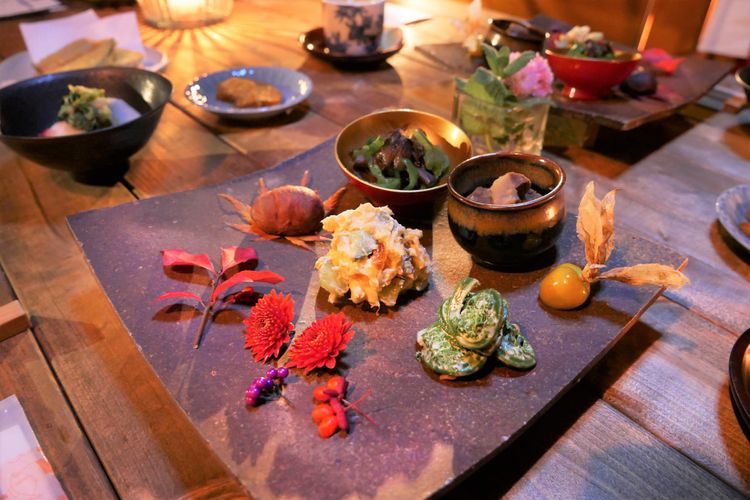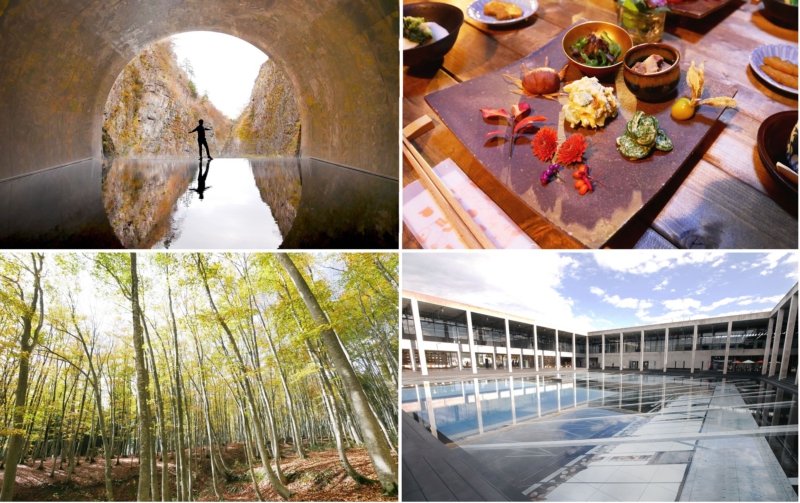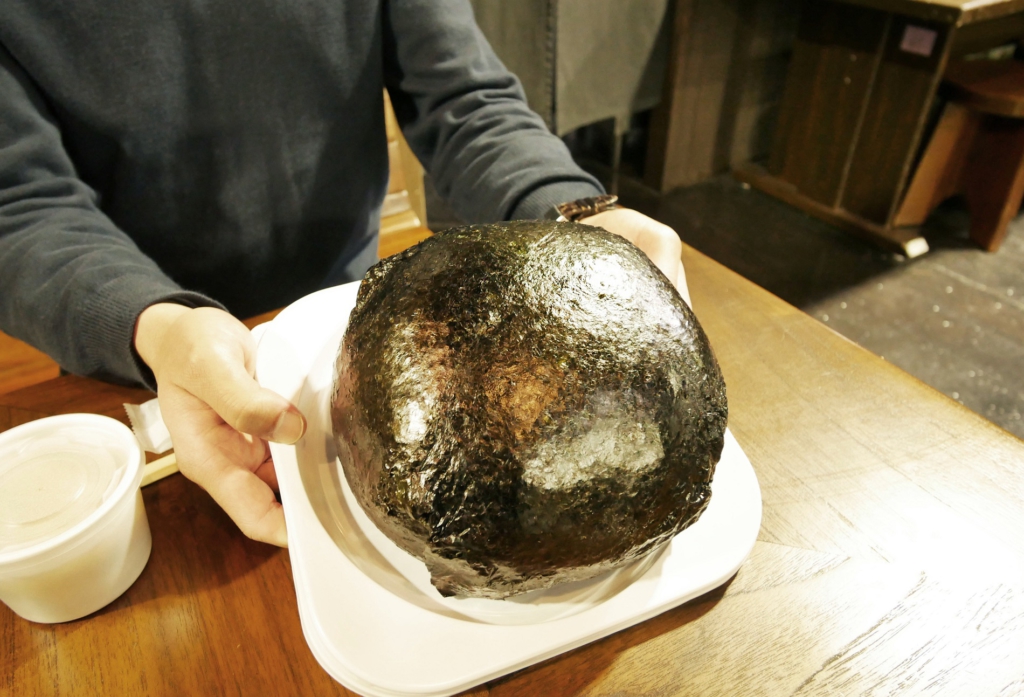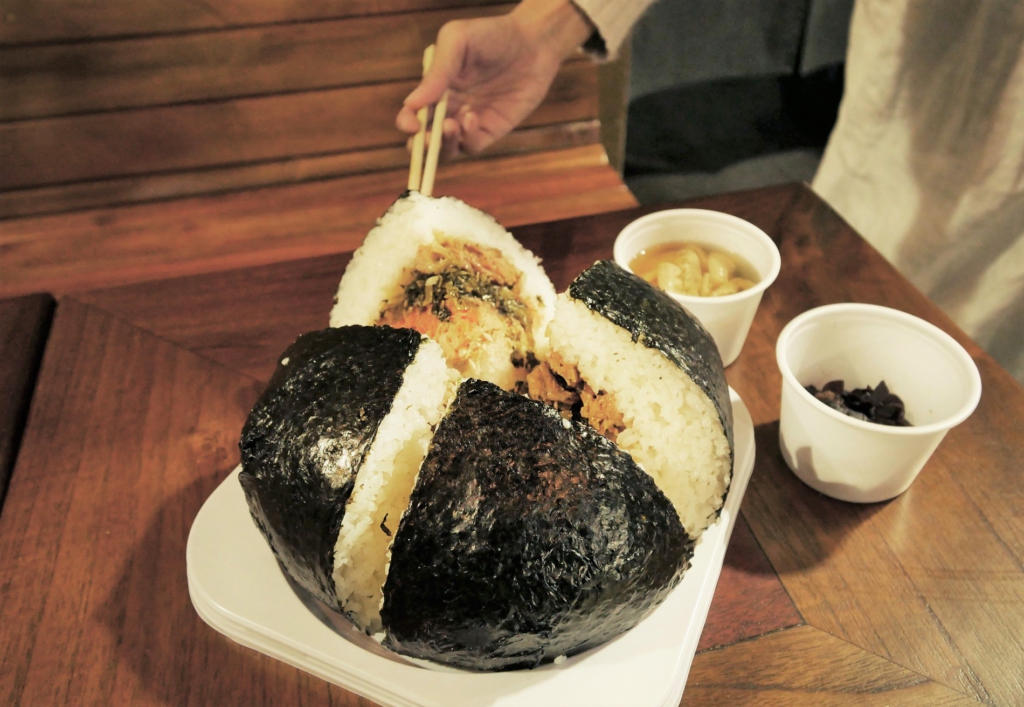Just over an hour away from Tokyo, the Tsunan, Tokamachi, and Yuzawa regions of Niigata Prefecture are celebrated for their vast fields of art skillfully woven into the surrounding natural landscapes. One of the best times to enjoy this region is during autumn, when the fiery fall foliage and pleasant weather amplifies the existing beauty. In this article, we’ll introduce 9 places across the Tsunan, Tokamachi, and Yuzawa regions of Niigata to relish both natural and manmade art, along with a helping of unmissable gourmet and accommodation recommendations!
*This article was written in collaboration with Niigata Prefecture.
Where Is Niigata Prefecture?

Niigata Prefecture is a part of the Chubu region of Japan and sits roughly 200 km northwest of Tokyo. Being Japan’s 5th largest prefecture, it is characterized by a sweeping coastline facing the Sea of Japan alongside an expansive inland terrain of rugged mountains with heavy snowfall in winter, lush greenery in summer, and vivid foliage in autumn. The inland Tsunan, Tokamachi, and Yuzawa regions are particularly renowned for their ski resorts, artistic community, and unique cultures. These regions neighbor the borders of Nagano and Gunma Prefecture and can be easily accessed via the Joetsu Shinkansen bullet train from Tokyo Station to Echigo-Yuzawa Station in approximately 79 mins.
When is Autumn in Niigata Prefecture?
Peak autumn foliage is generally seen in the Tsunan, Tokamachi, and Yuzawa regions of Niigata between mid-October and early November. However, this can change depending on the year, so always confirm the latest information online before making any plans.
Best Places to See in Niigata (Tokamachi, Tsunan, Yuzawa)
1. Tunnel of Light (Kiyotsu Gorge Tunnel)

The Tunnel of Light is a dazzling art installation transporting visitors through a dark, atmospheric underpass deep into the majestic Kiyotsu Gorge. The 750 m tunnel is lined with several spectacular viewing platforms framing and enhancing the gorge’s natural beauty. The most famous of these is the Light Cave at the end of the tunnel (seen above), which uses mirror-like shallow water to reflect and amplify the impact of the valley scenery. Each season is an entirely different look, with autumn casting a hazel hue from the withering foliage encapsulating the essence of the season.

Alongside Kurobe Gorge in Toyama and Osugidani in Mie, Kiyotsu Gorge is considered one of Japan’s three greatest valleys. While the rugged, untouched scenery has attracted visitors for generations, its soaring cliffs and powerful river current made it a perilous adventure. After a rock fall in 1988, the gorge was closed to visitors and a tunnel was instead opened in 1996 to allow safe passage for sightseers. In 2018, the tunnel was incorporated into the Echigo-Tsumari Art Triennial festival and reborn as the Tunnel of Light artwork by MAD Architects, a trio of renowned creatives founded by Chinese architect Ma Yansong. While the best time to take photos of the gorge is generally considered to be the afternoon, we suggest visiting during the morning to avoid crowds and capture a shot without other people. Also, if you want to walk to the edge of the Light Cave, you’ll need to step in shallow water, so bring suitable footwear.

Other highlights at Kiyotsu Gorge include the psychedelic black and white “Flow” lookout and its futuristic “Invisible Bubble” toilet with a see-through wall from the inside; the subdued and moody “Drop” lookout adorned by dozens of mirrors illuminated by a fiery backlight; and the chic, stylish cafe and footbath adjacent to the tunnel entrance. There are also several traditional Japanese ryokan inns in the neighboring hot spring town if you wish to spend the night nearby.
| Name | Tunnel of Light (Kiyotsu Gorge Tunnel) |
|---|---|
| Opening hours | 8:30 AM – 5:00 PM (Last entry 4:30 PM) |
| Closing days | None |
| Price | – Adults (16+): 800 yen – Children (7-15): 400 yen – Infants: Free |
| Address | 2119-2, Koide, Tokamachi-shi, Niigata 新潟県十日町市小出2119-2 Google Maps |
| Access | Approx. 25 min drive from JR Echigo-Yuzawa Station or 25 mins on the high-speed bus from JR Echigo-Yuzawa Station heading to Morimiyanohara and a further 30 min walk from the bus stop. |
| Website (Japanese) | https://nakasato-kiyotsu.com/ |
| Website (English) | https://nakasato-kiyotsu.com/en/ |
| Other | – To reduce crowding during peak times, an advanced reservation system is used for entry to the Tunnel of Light (reservation period and other details can be confirmed on the official website). – Tunnel may temporarily close in winter due to snowfall. – Cafe and footbath are closed during the peak of winter. |
2. Beauty Forest (Bijin-bayashi)

While not an art installation, the Beauty Forest was unwittingly born from the influence of humans on the environment. Despite the respect for nature seen today, the large-scale industrialization of Japan towards the end of the Taisho period (1912-1926) resulted in many forests being cut down for charcoal and more. However, a certain forest in Tokamachi bounced back to life, sprouting hundreds of beech trees which gradually grew into the gorgeous “Beauty Forest” we enjoy today.

While each season is a wonder in its own right, the charm of the Beauty Forest peaks during autumn as the foliage turns a regal gold before dropping down and weaving together a thick carpet of dark red. The trees, which are now all roughly 100 years old, stand tall, straight, and evenly spaced, making it feel like a carefully manicured garden. Because of the former deforestation, the forest also lacks the dense, unruly undergrowth common in outdoor Japan, allowing visitors to step off the track and uncover all the gems amongst the spacious 30,000 m² grounds. The best time to see autumn colors in the Beauty Forest is generally between early to mid-November.
| Name | Beauty Forest (Bijin-bayashi) |
|---|---|
| Opening hours | Free |
| Closing days | None |
| Price | Free |
| Address | 1712-2, Matsuguchi, Matsunoyama, Tokamachi-shi, Niigata 新潟県十日町市松之山松口1712-2 Google Maps |
| Access | Approx. 30 min drive from JR Tokamachi Station. Alternatively, take the Hokuetsu Kyuko Hokuhoku Line from JR Echigo-Yuzawa Station to Matsudai Station. The forest is a further 15 min taxi ride from there. |
| Website (Japanese) | https://www.tokamachishikankou.jp/spot/bijinbayashi/ |
| Website (English) | https://www.tokamachishikankou.jp/en/spot/bijinbayashi_en/ |
| – Snow shoes are required when entering the forest during winter. Confirm the current situation at the forest before heading out. – Snow shoes can be rented from the nearby Forest School: Kyororo. (Echigo Matsunoyama Forest School: Kyororo) – Tokamachi Satoyama Science Museum |
3. Museum on Echigo-Tsumari (MonET)

Stepping aside from nature for a moment, Museum on Echigo-Tsumari (MonET) is an invigorating hub of modern creativity and a must-visit for lovers of contemporary art. Freshly revamped in July 2021, the spacious, incredibly designed concrete complex is centered around a large, shallow pool. In 2018, this pool was decorated with art by Leandro Erlich, forming a surreal, trick-art-like amalgamation between the illustration on the bottom of the pool and the reflection of the building on the water’s surface.

Inside the museum are several exhibits by a mix of celebrated Japanese and international artists. Particular highlights include “movements” by Japanese art team “mé” featuring a hypnotizing display of countless tiny hanging clocks resembling a flock of starlings.

Other must-sees include “16 Ropes” by Ilya & Emilia Kabakov, a display of disused pieces of trash hanging from ropes alongside prints of random conversations encapsulating everyday life in the Soviet Union; “Force,” a hypnotic arrangement of thread-like lines of freely flowing black silicone oil visualizing gravity; and “Lost#6,” an riveting shadow show cast by the light of a model train. Museum on Echigo-Tsumari (MonET) also boasts two cafes, plenty of comfortable sitting space, shops to browse and purchase local goods and art products, and even a hot spring!
| Name | Museum on Echigo-Tsumari (MonET) |
|---|---|
| Opening hours | 10:00 AM – 5:00 PM (Last entry 4:30 PM) |
| Closing days | Wednesday |
| Price | – Adults: 1,000 yen – Children (elementary/junior high): 500 yen Includes Both Permanent and Special Exhibitions |
| Address | 6-1, Honcho, Tokamachi-shi, Niigata 新潟県十日町市本町6-1 Google Maps |
| Access | Approx. 10 min walk from JR Tokamachi Station. |
| Website (Japanese) | https://www.echigo-tsumari.jp/travelinformation/smcak/ |
| Website (English) | https://www.echigo-tsumari.jp/en/art/artwork/echigo-tsumari_kouryukan_echigo-tsumari_exchange_center/ |
| Other | Was formerly known as the Echigo-Tsumari Satoyama Museum of Contemporary Art, KINARE. |
4. Nadai Kisoba Yoshiya

Being one of the most prosperous breadbaskets of Japan, Niigata has no shortage of delicacies to feast on! One of the most intriguing is “hegi soba,” a local twist on the classic Japanese soba noodle using seaweed as a binding agent arranged in delightful little bundles. With a solid texture and firm mouthfeel, each bundle retains its shape even when picked up, making them easy to handle for those lacking in chopstick skills.

While there are a number of esteemed restaurants in Niigata serving up hegi soba, one of the best and easiest to find is Nadai Kisoba Yoshiya, located in the Doichi area of Tokamachi. The hegi soba served here is handmade from carefully selected local buckwheat to be ground, combined with “funori” seaweed, and made into noodles all in-store.
The soba is arranged on large “hegi” trays, the origin behind its name, and is eaten by dipping each bundle into the accompanying “tsuyu” sauce, which can be further flavored by spring onion and mustard. While simple, the satisfying bite and wholesome flavor prevents it from becoming tiresome no matter how many bundles you eat. Best of all, being full of dietary fiber, minerals, and catechin, hegi soba also makes for a surprisingly guilt-free pick-me-up!

If you’re still hungry, the tempura at Nadai Kisoba Yoshiya is also highly regarded. Along with classics like shrimp, pumpkin, potato, and capsicum are some more unusual options including chrysanthemum flower, ashitaba plant, and yukishita ninjin carrots, which are a sweet and luscious carrot grown under the snow in a special cultivation method discovered in Tsunan.
| Name | Nadai Kisoba Yoshiya |
|---|---|
| Opening hours | – Weekdays: 10:30 AM – 2:00 PM (last order), 3:30 PM – 5:30 PM (last order) – Thursdays: 10:30 AM – 2:00 PM (last order) – Weekends/Public Holidays: 10:30 AM – 5:30 PM (last order) |
| Closing days | Tuesday |
| Price | – Small Hegi Soba (2 people): 2,000 yen – Tempura: 900 yen |
| Address | Dai 4, Doichi, Tokamachi-shi, Niigata 新潟県十日町市土市第4 Google Maps |
| Access | Approx. 5 min walk from JR Doichi Station. |
| Website (Japanese) | https://www.tokamachishikankou.jp/spot/nadaikisoba_yoshiya/ |
| Other | Some days may close earlier than usual. |
5. Hoshitoge Rice Terraces

It wouldn’t be Niigata and Tokamachi without rice! While much of the Uonuma region’s renowned “koshihikari” rice is grown on the flat plains, the mountainous inland countryside is likewise dotted by magnificent rice terraces straddling the steep terrain. One of the most famous of these are the Hoshitoge Rice Terraces in the Matsudai area of Tokamachi.
With the gorgeous seasonal scenery and changing sunlight yielding a new look almost every hour, a visit to the Hoshitoge Rice Terraces is worthwhile no matter the time of year or day. Spring sees the paddies flooded with water and filled with tiny rice plants, creating a mirror-like surface reflecting the sky and clouds. In summer the fields burst with fresh, verdant greenery before being cut down and harvested during mid-September.

Autumn is also a fantastic time to visit the Hoshitoge Rice Terraces, with lucky sightseers able to witness the rice harvest unfold, enjoy reflections on the water-filled fields, and even witness a “sea of clouds” hovering over the valley during the early morning. Be aware that this is working farmland and not a tourist attraction, so please refrain from entering the fields or disturbing operations.
| Name | Hoshitoge Rice Terraces |
|---|---|
| Opening hours | Free |
| Closing days | None |
| Price | Free |
| Address | Toge, Tokamachi-shi, Niigata 新潟県十日町市峠 Google Maps |
| Access | Approx. 40 min drive from JR Tokamachi Station or 20 min taxi ride from Matsudai Station, which can be accessed from JR Echigo-Yuzawa Station via the Hokuetsu Kyuko Hokuhoku Line. |
| Website (Japanese) | https://www.tokamachishikankou.jp/spot/hoshitougenotanada/ |
| Website (English) | https://www.tokamachishikankou.jp/en/special/special-tanada/ |
6. Abandoned Elementary School (Katakuri House)

Katakuri House is an accommodation facility, art installation, and hot spring bath house built inside a rustic wooden former elementary school. For over 100 years, Ketto Elementary educated the children of the isolated Akiyamago region on the border of Niigata and Nagano, serving as a local icon binding the rural township together. Due to a decline in students, the school closed in 1992, which was particularly tough on the surrounding residents after they had fought hard to provide an education for their children. Because of this, instead of being demolished, it was refurbished in 1993 as “Katakuri House,” a community facility inviting visitors to discover and experience the Akiyamago way of life.

Katakuri House now hosts seven Japanese-style tatami rooms built from renovated classrooms allowing visitors to spend the night. There is also a hot spring bath to warm the body alongside vivid artistic installations including “Tsumari Sugoroku” (pictured above/by Hara Rintaro and Hara Yu), which is a part of the greater Echigo-Tsumari Art Field. Overnight guests can also select to have dinners and breakfasts included in their accommodation plan, which feature local specialities showcasing the traditional tastes of the area (read more on food below).

Katakuri House offers a fresh, exciting stay for those who’ve already had the Japanese ryokan, capsule hotel, and townhouse experience and are seeking something new. To see the available Katakuri House accommodation plans, check out the official booking website.
| Name | Katakuri House |
|---|---|
| Check-in | 3:00 PM |
| Check-out | 10:00 AM |
| Price | Various plans available, including meals and no meals. Check the website for details. |
| Address | 450-1, Ketto, Nakauonuma-gun, Tsunan-cho, Niigata 新潟県中魚沼郡津南町結東450-1 Google Maps |
| Access | Approx. 25 min drive from JR Tsunan Station or 45 min ride on the high-speed bus from JR Echigo-Yuzawa Station heading to Morimiyanohara Station and getting off at Tsunanyakubamae. |
| Website (Japanese) | http://www.tsumari-artfield.com/katakuri/ |
| Website (English) | https://www.echigo-tsumari.jp/en/travelinformation/katakurihouse/ |
| Other | Amenities include toothbrushes, free wifi, bath towels, kimono, shampoo, conditioner, body soap, etc. Bath is a shared gender-seperated Japanese-style onsen hot spring. |
7. Glamping at Katakuri House

Katakuri House has also opened up a luxury glamping facility featuring a roomy, warm tent pitched on the school’s former sports ground. With almost no surrounding artificial light nearby, the crystal clear night sky beams with stars often appearing brightest during the long, dark, and crisp autumn nights. Like the school guestrooms, glampers will be served breakfast and dinner inside a dining tent of fresh seasonal ingredients crafted into exotic local delicacies sure to surprise even the most well-versed in Japanese cuisine.

While meals change depending on the season and availability, the autumn dinner served at the time of this article provides good insight into the cuisine at Katakuri House. As seen above, the refined presentation embodies the spirit of autumn itself, with decorative red foliage and fall berries adjoining a feast of local delicacies like ostrich fern, amandare mushroom, Japanese chestnut, kaki persimmon, Tsumari pork, aburaage fried tofu, native mountain vegetables, and even locally hunted bear meat! Each ingredient flaunts a taste and texture rarely experienced outside the community, serving as an intimate tour of the regional gastronomy. Those staying inside Katakuri House will also receive the same kind of meals, so you won’t miss out even if glamping isn’t your thing!

| Name | Glamping Katakuri House |
|---|---|
| Check-in | 3:00 PM |
| Check-out | 10:00 AM |
| Price | 14,800 per person (1 night, 2 meals) |
| Address | 450-1, Ketto, Nakauonuma-gun, Tsunan-cho, Niigata 新潟県中魚沼郡津南町結東450-1 Google Maps |
| Access | Approx. 23 min drive from JR Tsunan Station or 45 min ride on the high-speed bus from JR Echigo-Yuzawa Station heading to Morimiyanohara Station and getting off at Tsunanyakubamae. |
| Website (Japanese) | https://www.glamping-style.com/ |
| Other | – Glamping guests are free to use Katakuri House facilities including toilets and hot spring baths. Amenities include toothbrushes, free wifi, towels, shampoo, conditioner, body soap, etc. – Kimono is not included, please bring your own clothes for sleeping. – May shut during winter due to snowfall. Check the official website for more details. |
8. Ryugakubo Water Spring

The mysterious Ryugakubo Water Spring is one of Niigata’s most well-kept secrets. Quietly resting amongst undisturbed nature, this pristine body of spring water is known for its vivid emerald green hue enrapturing all those who find it. Its beauty is heightened in autumn by a surrounding tapestry of crimson fall leaves adding color to the water’s mirror-like surface.

Everyday, roughly 43,000 tons of spring water wells up from the ground at Ryugakubo, constantly replenishing the pond and preventing it from stagnating. While the pond itself is a little difficult to access, the path to the spring has a dragon statue spouting free-flowing Ryugakubo water to taste and take home. Being the township’s sole source of water, the area is considered sacred, with shrines and festivals honoring its invaluable contributions. Local legend states that the spring was created by a dragon, which explains the aforementioned dragon statue along with the spring’s name, with the “ryu” in Ryugakubo meaning “dragon” in Japanese.
| Name | Ryugakubo Water Spring |
|---|---|
| Opening hours | Free |
| Closing days | Shut during winter |
| Price | 200 yen parking fee (for regular vehicles) |
| Address | 6217, Yachi, Tsunan-cho, Nakauonuma-gun, Niigata 新潟県中魚沼郡津南町谷内6217 Google Maps |
| Access | Approx. 15 min drive from JR Tsunan Station |
| Website (Japanese) | https://niigata-kankou.or.jp/spot/6988 |
| Website (English) | https://enjoyniigata.com/en/spot/6988 |
9. Ponshukan

With an abundance of rice and exceptional spring water, it’s no surprise that the sake of Niigata is considered some of the best in Japan. Conveniently located within Echigo-Yuzawa Station, Ponshukan is a wonderland of Niigata sake famed for its automatic tasting machines dishing out sake from each Niigata brewery, including rare brews not found anywhere else.

For 500 yen, you’ll receive five tokens to use for five cups of sake (or less, as some expensive brews require additional tokens). There’s a staggering range to try complementing all kinds of palates, from potent super dries to sweet and fruity wine-like brews. Thankfully, recommendations are posted on the wall in English, so feel free to give them a shot if you’re feeling overwhelmed!

For a local brew, we recommend “Jozen Mizu no Gotoshi” from Shirataki Sake Brewery, which is brewed just a few minutes’ walk from the station. For beginners, the fragrant and sweet “Kayama” from DHC Sake Brewery is a pleasant introductory brew sure to get you hooked. Pros should try “Hanakoshiji” or “Midorigawa,” which are both highly sought-after by sake aficionados for their crisp, fresh tastes embodying the character of a typical Niigata sake. If sake isn’t your thing or you need a break, there are also several local red wines and umeshu plum wines equally worth a taste.
Of course, drinking on an empty stomach is never a good idea, which is where “onigiri” comes in handy. Ponshukan’s “Yukinto” eatery serves freshly made onigiri rice balls with local koshihikari rice in a remarkable variety of sizes, including the “bomb” (from 370 yen) containing two bowls of rice and the “explosion” (2,200 yen) with a whopping 8 bowls! You can select fillings from a wide assortment of ingredients, such as miso, cod roe, salmon roe, pork, and more, with the explosion onigiri holding up to five different ingredients. Naturally, you won’t be able to polish off an entire explosion by yourself, which is why it’s best split up and shared. No matter the size, each onigiri is warm, fresh, and absolutely delicious!
Afterwards, you’ll be able to browse through Ponshukan’s extensive collection of local Niigata goods and souvenirs, including delicacies like sake, yogurt, cheese, rice crackers, miso, soy sauce, and more, alongside crafts such as ceramics, fabrics, and the renowned Tsubame-Sanjo metalwork. Being inside Echigo-Yuzawa Station along with outlets in Niigata Station and Nagaoka Station, the bullet train is just a brief walk away, making Ponshukan a convenient final stop to wrap up your Niigata adventure!
| Name | Ponshukan Echigo-Yuzawa Station |
|---|---|
| Opening hours | – Store: 10:00 AM – 6:30 PM – Sake Tasting Room: 10:00 AM – 6:30 PM (Last Order 6:15 PM) *Hours may be extended during winter |
| Closing days | None |
| Address | 2427-3, Yuzawa, Yuzawa-machi, Minamiuonuma-gun, Niigata 新潟県南魚沼郡湯沢町湯沢2427-3 Google Maps |
| Access | Inside Echigo-Yuzawa Station (at the back end furthest from the ticket gates on the second floor) |
| Website (Japanese) | https://www.ponshukan.com/ |
| Website (English) | https://www.ponshukan.com/en/ |
Dive Into the Heartland of Niigata
With the Joetsu Shinkansen bullet train cutting through the formidable Echigo Mountains, the formerly isolated Tokamachi, Tsunan, and Yuzawa regions of Niigata can now be accessed directly from Tokyo with ease. Due to the millenniums of isolation before modern technology, the cultures that have flourished here practice a distinctive way of life revolving around creativity, cuisine, and nature. With hundreds of fascinating and ever-expanding exhibitions of both natural and manmade art, this unique culture is stronger than ever before!
Furthermore, each season brings a new character to the region, with autumn boasting stunning fall foliage, fresh produce, and invigorating weather. If you’re seeking an outdoor adventure amongst alluring art, fantastic food, and imaginative cultures, then we recommend jumping on the Joetsu Shinkansen in autumn to uncover the tantalizing hidden gems of rural Niigata!
The places introduced here were visited by Instagram influencer @cheeserland! Check out her Instagram profile to discover more wonders of Niigata!
If you want to give feedback on any of our articles, you have an idea that you’d really like to see come to life, or you just have a question on Japan, hit us up on our Facebook, Twitter, or Instagram!
The information in this article is accurate at the time of publication.



